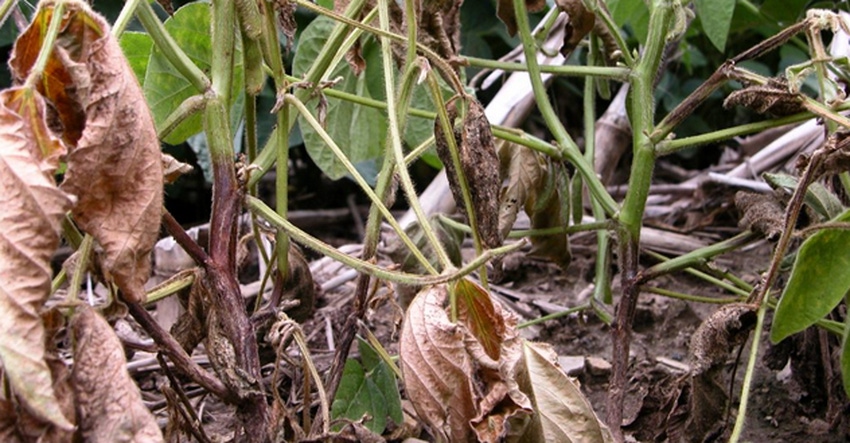June 26, 2018

By Lauren Quinn
Severe storms mixed with two soilborne pathogens may result in soybean seedling damage.
“In many cases, rhizoctonia has been identified as the causative organism, alone or in combination with other soil diseases such as phytophthora,” says Nathan Kleczewski, plant pathologist in the Department of Crop Sciences at the University of Illinois.
“We are seeing what appear to be signs of early-season rhizoctonia infection. The plants are responding to pathogen infection and a reduction in initial root systems by producing small, adventitious roots. The recent, severe rains inundated these plants, allowing adventitious roots to be infected by phytophthora. There was not much of a root system left, so it did not take much to cause blighting in many cases. Thus, we have a seedling-disease complex likely caused by different pathogens and the severe shifts in environmental conditions after planting.”
Rhizoctonia kills germinating and emerging seedlings, but the disease also affects larger plants by forming stem cankers, or sunken lesions, at and slightly above the soil line. Large cankers can severely reduce the translocation of water and nutrients up the stem, causing the plant to wilt and potentially die. Affected plant tissues tend to appear reddish-brown and will have a corky, almost dry-rotted look to them.
Rhizoctonia becomes problematic when soils are moist and warm, forming patches within a field. Soybean varieties differ in their tolerance, but there is no true resistance to the disease.
Kleczewski says rhizoctonia seed treatments can be effective for reducing early infections, but these products are only effective for the first week or two after planting and are unlikely to impact disease occurring later in crop development.
A look at phytophthora
Farmers should also expect outbreaks of phytophthora, especially in low-lying, poorly drained areas of a field. Phytophthora lesions on stems are black or brown and extend from the roots up the lower stem of the plant. The margins of the lesions are less defined than in rhizoctonia-infected plants, and are soft and mushy.
“When soils are saturated and warm, the overwintering structure of this pathogen, a water mold, germinates, producing another structure that releases small spores into the soil solution,” Kleczewski explains. “These spores have tails, or flagellae, that propel the spores in the water. Then, the spores sense gradients in chemicals from plant roots to locate and infect root systems.”
Two types of resistance are available for management of Phytophthora: race-specific (Rps) and partial.
“Race-specific is like a door that will completely block specific types of phytophthora from infecting plants. However, some phytophthora individuals contain a key that allows them to open that door and infect roots, and you may still see significant infection,” Kleczewski says.
The most common Rps genes are Rps1a, Rps1c, Rps1k, Rps3a and Rps6. Although many varieties only have a single Rps gene, some have multiple, or stacked, Rps genes.
“Partial resistance acts like a bouncer guarding the stage at a concert,” Kleczewski says. “It provides some resistance to all populations of phytophthora, but some disease can occur, like rowdy fans who eventually jump on stage, only to be pulled off.”
Partial resistance is not expressed until later in plant development — typically after the first true leaves are produced — and is not effective for managing early infections. Kleczewski points out that phytophthora is not a true fungus but an oomycete, and therefore, seed treatments must contain oomycete-specific active ingredients such as metalaxyl, mefanoxam or ethaboxam.
“In a case like this, it is important to realize that seed treatments are not going to help much. We are 30 to 45 days post planting, and your fungicide treatments ran out of gas a while ago,” Kleczewski says.
For more information on seed treatments, visit the Illinois Field Crop Disease Blog.
Quinn is a writer for the University of Illinois College of Agricultural, Consumer and Environmental Sciences.
You May Also Like




